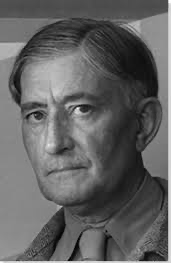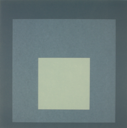Josef Albers
American, born Germany
American, born Germany, (1888–1976)
Albers was born into a Roman Catholic family of craftsmen in Bottrop, Westphalia, Germany in 1888. His father, Lorenzo Albers, was variously a housepainter, carpenter, and handyman. His mother came from a family of blacksmiths. His childhood included practical training in engraving glass, plumbing, and wiring, giving Josef versatility and lifelong confidence in the handling and manipulation of diverse materials. He worked from 1908 to 1913 as a schoolteacher in his home town; he also trained as an art teacher at Königliche Kunstschule in Berlin, Germany, from 1913 to 1915. From 1916 to 1919 he began his work as a printmaker at the Kunstgewerbschule in Essen, where he learnt stained-glass making with Dutch artist Johan Thorn Prikker.[5] In 1918 he received his first public commission, Rosa mystica ora pro nobis, a stained-glass window for a church in Essen.[3] In 1919 he moved to Munich, Germany, to study at the Königliche Bayerische Akademie der Bildenden Kunst, where he was a pupil of Max Doerner and Franz Stuck. Albers enrolled as a student in the preliminary course (vorkurs) of Johannes Itten at the Weimar Bauhaus in 1920. Although Albers had studied painting, it was as a maker of stained glass that he joined the faculty of the Bauhaus in 1922, approaching his chosen medium as a component of architecture and as a stand-alone art form. The director and founder of the Bauhaus, Walter Gropius, asked him in 1923 to teach in the preliminary course 'Werklehre' of the department of design to introduce newcomers to the principles of handicrafts, because Albers came from that background and had appropriate practice and knowledge. In 1925, the year the Bauhaus moved to Dessau, Albers was promoted to professor. At this time, he married Anni Albers (née Fleischmann) who was a student at the institution. His work in Dessau included designing furniture and working with glass. As a younger instructor, he was teaching at the Bauhaus among established artists who included Oskar Schlemmer, Wassily Kandinsky, and Paul Klee. The so-called "form master" Klee taught the formal aspects in the glass workshops where Albers was the "crafts master"; they cooperated for several years. With the closure of the Bauhaus under Nazi pressure in 1933 the artists dispersed, most leaving the country. Albers emigrated to the United States. The architect Philip Johnson, then a curator at the Museum of Modern Art in New York City, arranged for Albers to be offered a job as head of a new art school, Black Mountain College, in North Carolina.[8] In November 1933, he joined the faculty of the college where he was the head of the painting program until 1949. At Black Mountain, his students included Ruth Asawa, Ray Johnson, Robert Rauschenberg, Cy Twombly, and Susan Weil. He also invited important American artists such as Willem de Kooning, to teach in the summer seminar. Weil remarked that, as a teacher, Albers was "his own academy". She said that Albers claimed that "when you're in school, you're not an artist, you're a student", although he was very supportive of self-expression when one became an artist and began on her or his journey.[9] Albers produced many woodcuts and leaf studies at this time. In 1950, Albers left Black Mountain to head the department of design at Yale University in New Haven, Connecticut. While at Yale, Albers worked to expand the nascent graphic design program (then called "graphic arts"), hiring designers Alvin Eisenman, Herbert Matter, and Alvin Lustig. Albers worked at Yale until he retired from teaching in 1958. At Yale, Richard Anuszkiewicz, Eva Hesse,[11] Neil Welliver, and Jane Davis Doggett were notable students. In 1962, as a fellow at Yale, he received a grant from the Graham Foundation for the Advanced Studies of Fine Arts for an exhibit and lecture on his work. Albers also collaborated with Yale professor and architect King-lui Wu in creating decorative designs for some of Wu's projects. Among these were distinctive geometric fireplaces for the Rouse (1954) and DuPont (1959) houses, the façade of Manuscript Society, one of Yale's secret senior groups (1962), and a design for the Mt. Bethel Baptist Church (1973). Also, at this time he worked on his structural constellation pieces. Also during this time, he created the abstract album covers of band leader Enoch Light's Command LP records. His album cover for Terry Snyder and the All Stars 1959 album, Persuasive Percussion, shows a tightly packed grid or lattice of small black disks from which a few wander up and out as if stray molecules of some light gas. He was elected a Fellow of the American Academy of Arts and Sciences in 1973. Albers continued to paint and write, staying in New Haven with his wife, textile artist Anni Albers, until his death in 1976.
Accomplished as a designer, photographer, typographer, printmaker, and poet, Albers is best remembered for his work as an abstract painter and theorist. He favored a very disciplined approach to composition, especially in the hundreds of paintings and prints that make up the series Homage to the Square. In this rigorous series, begun in 1949, Albers explored chromatic interactions with nested squares. Usually painting on Masonite, he used a palette knife with oil colors and often recorded the colors he used on the back of his works. Each painting consists of either three or four squares of solid planes of color nested within one another, in one of four different arrangements and in square formats ranging from 406×406 mm to 1.22×1.22 m. Due to the dire circumstances, many of Germany’s greatest intellectuals and artists immigrated to other countries prior to WWII, including artists and educators Josef and Anni Albers. In 1933 Josef was invited to join the staff of Black Mountain College in North Carolina—another art school that had unorthodox (now normal) means of educating. Black Mountain staff and faculty included some of the United States’ most creative individuals including Willem and Elaine de Kooning, Robert Rauschenberg, Jacob Lawrence, Merce Cunningham, John Cage, Cy Twombly, Kenneth Noland, Ben Shahn, Ruth Asawa, Franz Kline, Arthur Penn, Buckminster Fuller, and many others who have made such a significant impact on the world. Even now, decades after its closing in 1957, the powerful influence of Black Mountain College continues to reverberate. (Incidentally, this school too came under scrutiny by another powerful government agency led by none other than J. Edgar Hoover, which likely expedited the avant-garde school’s closure in 1957.) Both Josef and Anni continued their prolific artistic paths in the United States. Josef developed his color theories and his Homage to the Square series of paintings and prints which is represented in the OJAC collection. The museum’s volume of Interactions of Color, originally printed in 1963 during his tenure at Yale University, represents decades of research and experimentation on the part of Josef Albers and still is one of most valuable sources of color theory available.
Source: wikipedia
American, born Germany
American, born Germany, (1888–1976)
Albers was born into a Roman Catholic family of craftsmen in Bottrop, Westphalia, Germany in 1888. His father, Lorenzo Albers, was variously a housepainter, carpenter, and handyman. His mother came from a family of blacksmiths. His childhood included practical training in engraving glass, plumbing, and wiring, giving Josef versatility and lifelong confidence in the handling and manipulation of diverse materials. He worked from 1908 to 1913 as a schoolteacher in his home town; he also trained as an art teacher at Königliche Kunstschule in Berlin, Germany, from 1913 to 1915. From 1916 to 1919 he began his work as a printmaker at the Kunstgewerbschule in Essen, where he learnt stained-glass making with Dutch artist Johan Thorn Prikker.[5] In 1918 he received his first public commission, Rosa mystica ora pro nobis, a stained-glass window for a church in Essen.[3] In 1919 he moved to Munich, Germany, to study at the Königliche Bayerische Akademie der Bildenden Kunst, where he was a pupil of Max Doerner and Franz Stuck. Albers enrolled as a student in the preliminary course (vorkurs) of Johannes Itten at the Weimar Bauhaus in 1920. Although Albers had studied painting, it was as a maker of stained glass that he joined the faculty of the Bauhaus in 1922, approaching his chosen medium as a component of architecture and as a stand-alone art form. The director and founder of the Bauhaus, Walter Gropius, asked him in 1923 to teach in the preliminary course 'Werklehre' of the department of design to introduce newcomers to the principles of handicrafts, because Albers came from that background and had appropriate practice and knowledge. In 1925, the year the Bauhaus moved to Dessau, Albers was promoted to professor. At this time, he married Anni Albers (née Fleischmann) who was a student at the institution. His work in Dessau included designing furniture and working with glass. As a younger instructor, he was teaching at the Bauhaus among established artists who included Oskar Schlemmer, Wassily Kandinsky, and Paul Klee. The so-called "form master" Klee taught the formal aspects in the glass workshops where Albers was the "crafts master"; they cooperated for several years. With the closure of the Bauhaus under Nazi pressure in 1933 the artists dispersed, most leaving the country. Albers emigrated to the United States. The architect Philip Johnson, then a curator at the Museum of Modern Art in New York City, arranged for Albers to be offered a job as head of a new art school, Black Mountain College, in North Carolina.[8] In November 1933, he joined the faculty of the college where he was the head of the painting program until 1949. At Black Mountain, his students included Ruth Asawa, Ray Johnson, Robert Rauschenberg, Cy Twombly, and Susan Weil. He also invited important American artists such as Willem de Kooning, to teach in the summer seminar. Weil remarked that, as a teacher, Albers was "his own academy". She said that Albers claimed that "when you're in school, you're not an artist, you're a student", although he was very supportive of self-expression when one became an artist and began on her or his journey.[9] Albers produced many woodcuts and leaf studies at this time. In 1950, Albers left Black Mountain to head the department of design at Yale University in New Haven, Connecticut. While at Yale, Albers worked to expand the nascent graphic design program (then called "graphic arts"), hiring designers Alvin Eisenman, Herbert Matter, and Alvin Lustig. Albers worked at Yale until he retired from teaching in 1958. At Yale, Richard Anuszkiewicz, Eva Hesse,[11] Neil Welliver, and Jane Davis Doggett were notable students. In 1962, as a fellow at Yale, he received a grant from the Graham Foundation for the Advanced Studies of Fine Arts for an exhibit and lecture on his work. Albers also collaborated with Yale professor and architect King-lui Wu in creating decorative designs for some of Wu's projects. Among these were distinctive geometric fireplaces for the Rouse (1954) and DuPont (1959) houses, the façade of Manuscript Society, one of Yale's secret senior groups (1962), and a design for the Mt. Bethel Baptist Church (1973). Also, at this time he worked on his structural constellation pieces. Also during this time, he created the abstract album covers of band leader Enoch Light's Command LP records. His album cover for Terry Snyder and the All Stars 1959 album, Persuasive Percussion, shows a tightly packed grid or lattice of small black disks from which a few wander up and out as if stray molecules of some light gas. He was elected a Fellow of the American Academy of Arts and Sciences in 1973. Albers continued to paint and write, staying in New Haven with his wife, textile artist Anni Albers, until his death in 1976.
Accomplished as a designer, photographer, typographer, printmaker, and poet, Albers is best remembered for his work as an abstract painter and theorist. He favored a very disciplined approach to composition, especially in the hundreds of paintings and prints that make up the series Homage to the Square. In this rigorous series, begun in 1949, Albers explored chromatic interactions with nested squares. Usually painting on Masonite, he used a palette knife with oil colors and often recorded the colors he used on the back of his works. Each painting consists of either three or four squares of solid planes of color nested within one another, in one of four different arrangements and in square formats ranging from 406×406 mm to 1.22×1.22 m. Due to the dire circumstances, many of Germany’s greatest intellectuals and artists immigrated to other countries prior to WWII, including artists and educators Josef and Anni Albers. In 1933 Josef was invited to join the staff of Black Mountain College in North Carolina—another art school that had unorthodox (now normal) means of educating. Black Mountain staff and faculty included some of the United States’ most creative individuals including Willem and Elaine de Kooning, Robert Rauschenberg, Jacob Lawrence, Merce Cunningham, John Cage, Cy Twombly, Kenneth Noland, Ben Shahn, Ruth Asawa, Franz Kline, Arthur Penn, Buckminster Fuller, and many others who have made such a significant impact on the world. Even now, decades after its closing in 1957, the powerful influence of Black Mountain College continues to reverberate. (Incidentally, this school too came under scrutiny by another powerful government agency led by none other than J. Edgar Hoover, which likely expedited the avant-garde school’s closure in 1957.) Both Josef and Anni continued their prolific artistic paths in the United States. Josef developed his color theories and his Homage to the Square series of paintings and prints which is represented in the OJAC collection. The museum’s volume of Interactions of Color, originally printed in 1963 during his tenure at Yale University, represents decades of research and experimentation on the part of Josef Albers and still is one of most valuable sources of color theory available.
Source: wikipedia
Artist Objects
Day and Night VII 1985.032
Interaction of Color 1985.034



